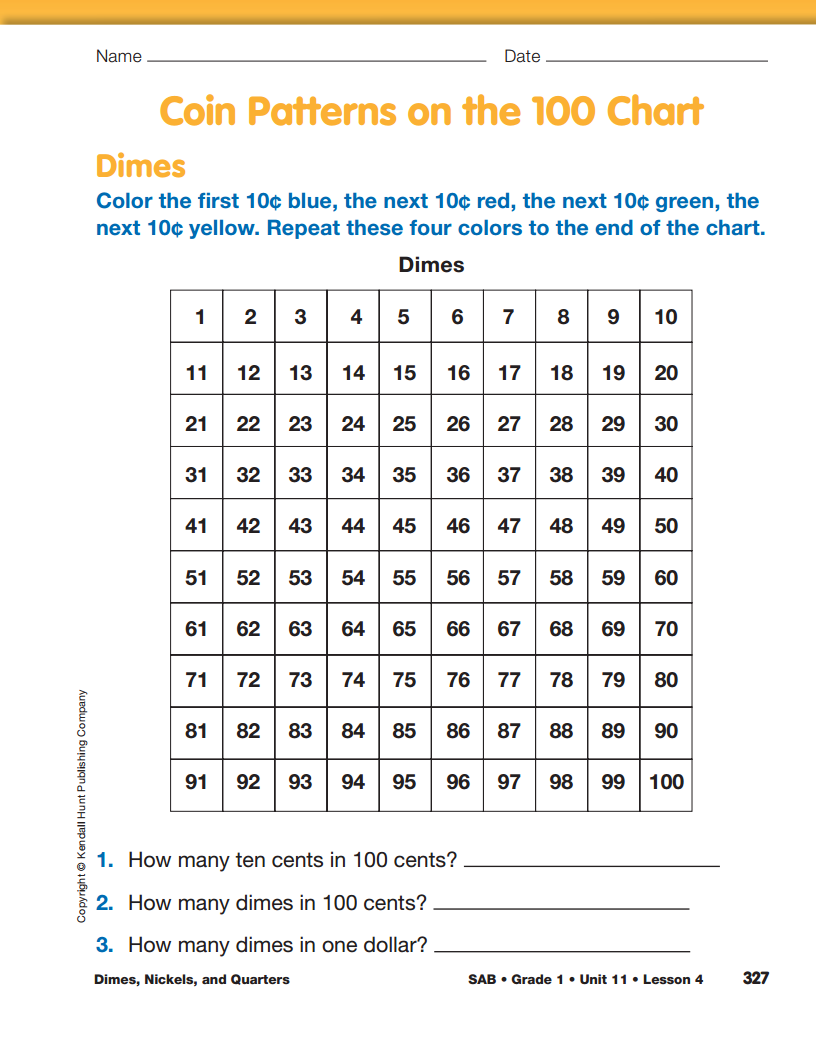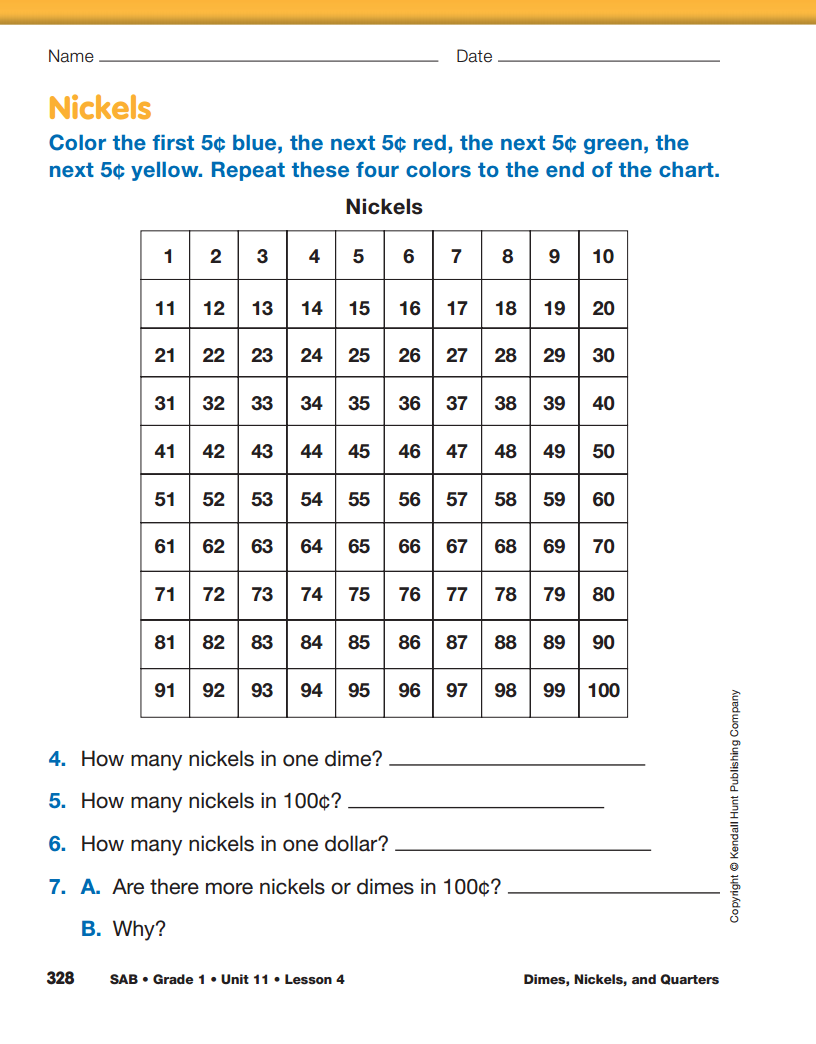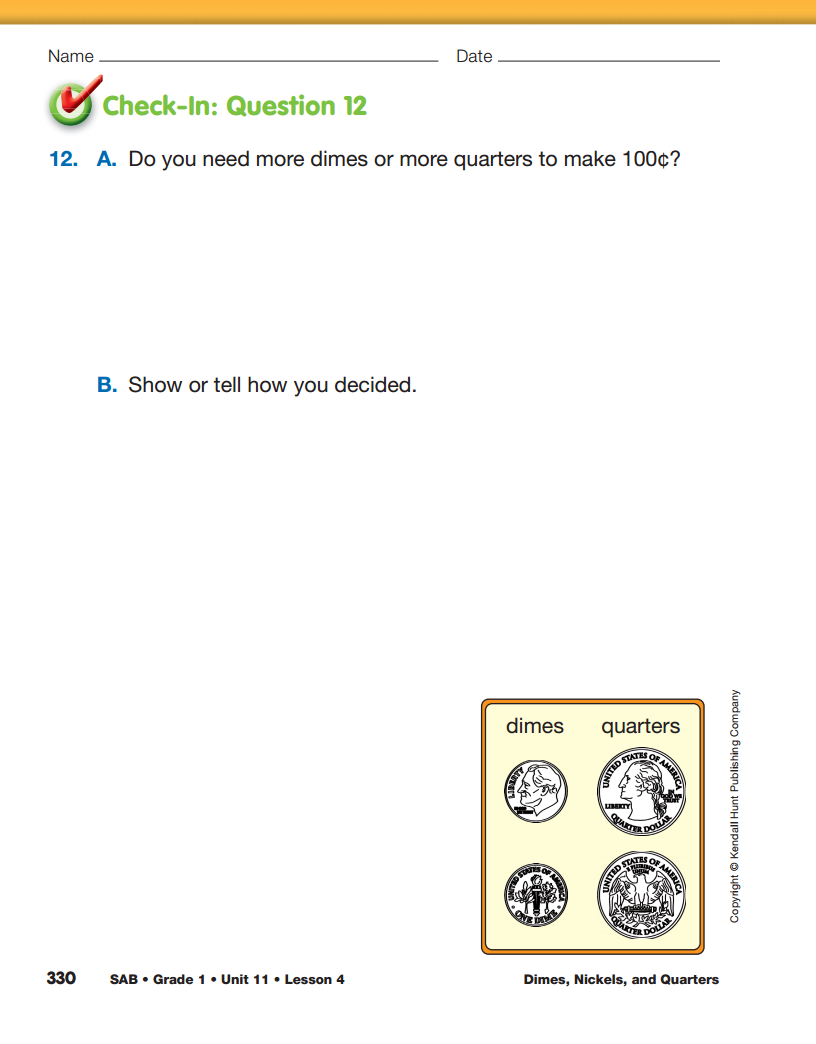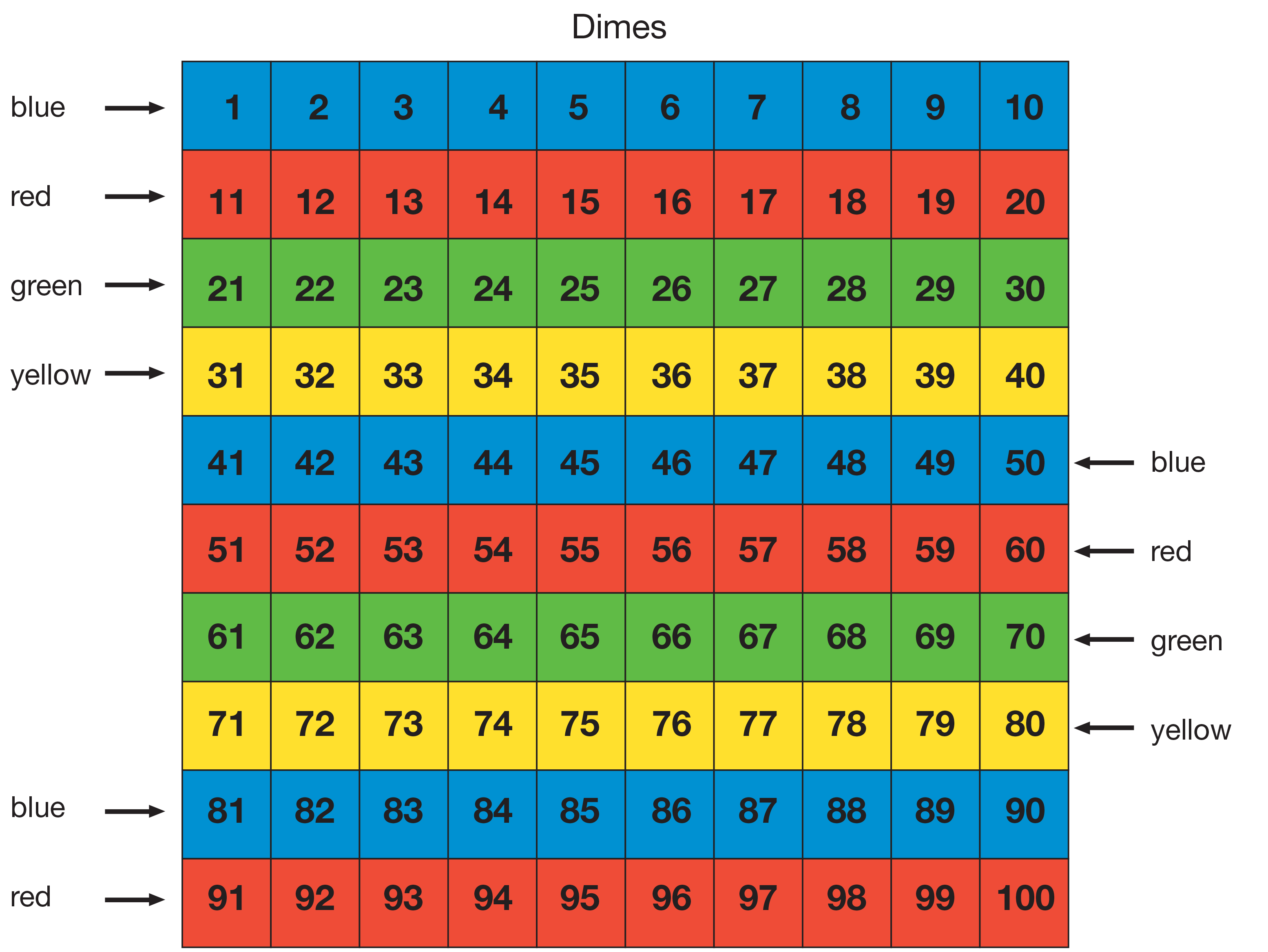Explore Dime Patterns. Begin by giving a volunteer
100 pennies and asking the student to give you
30¢. When the student is finished, point out to the
class how long it takes to count individual pennies.
Ask them to imagine how long it would take to
count out 100 pennies. Have another student hold
10 dimes, reminding students that a dime is worth
10 cents, or 10 pennies. Ask the student to give you
30¢ in dimes. Point out how much faster it is to
count by tens to 30 cents than by ones to 30 cents.
- Why is it useful to have coins of higher value than
pennies? (Possible response: You can use fewer
of them.)
- Name coins other than pennies or dimes that are
commonly used. How much are they worth in
cents? (nickel—5¢, quarter—25¢)
Using a display set of coins, show a nickel and
5 pennies, a dime and 10 pennies, a quarter and
25 pennies. Explain that each coin has the same
value as the number of pennies next to it.
- If I wanted to buy something for 25 cents but I
didn't have a quarter, what could I use instead?
(25 pennies)
- Would I be able to buy the same thing with the
25 pennies as with the quarter? (yes)
Display and direct students to the Dimes chart on the
first Coin Patterns on the 100 Chart page from the
Student Activity Book.
- How can we use this chart to represent dimes? (A
dime has ten pennies and every row has ten numbers,
so each row can represent one dime.)
Read the directions on the page aloud. Do the first
few colors of the dimes with the whole class. Make
sure that students understand that they repeat the
same four colors in order as they color the charts.
See Figure 1. Remind students of work they did with
patterns in Unit 9.
- What color pattern do you see? (blue, red, green, yellow, blue, red, green, yellow)
- How would we write this pattern in alphabet shorthand? (ABCDABCD)
- Can you figure out what the pattern unit would be? (ABCD)
When students have finished coloring the Dimes
chart, discuss the patterns they see using prompts
similar to the following and Questions 1–3.
- What pattern do you see on the Dimes chart?
(Possible responses: Each stripe went all the way
across the row of ten. I couldn't do the whole pattern
at the end. I had to stop after blue and red. I
didn't have room to color green and yellow.)
- How many stripes do you see on the chart? (There
are ten stripes.)
- What does that tell you about the number of dimes
in a dollar? (There are ten dimes in one dollar.)
Explore Nickel Patterns. Display and direct students
to the Nickels chart on the Coin Patterns on
the 100 Chart pages from the Student Activity Book.
- We colored an entire row to show a dime. How can
you show nickels on the chart? (Color only
five squares for each nickel then change colors.)
- How many colors will you use for each row?
Explain your thinking. (There will be two colors
on each row because 5 + 5 is 10.)
Using the same colors and ABCD pattern, do the
first few rows of the nickels with the whole class.
Make sure students understand that they use the
same four colors as on the Dimes chart, changing
colors after every five numbers are colored. See
Figure 2.
When students have finished coloring the Nickels
chart, discuss the patterns they see on the chart using
Questions 4–7. See the Sample Dialog.
- What pattern do you see on the Nickels chart? (There are two colors on each row.)
- What does that tell you about nickels? (Possible
response: They have less pennies than dimes.
Two nickels is one dime, like 5 + 5 = 10.)
- How can you show that using the 100 Chart?
(Possible response: One color goes only to 5 then
the next 5 goes to the end of the row. The dime is
one whole row, one color. The nickels need two
colors for the whole row, so two nickels are the
same as one dime.)
- How did you find the answer to Question 5?
(Possible responses: I skip counted by twos for
each row because each row shows two nickels.
I remembered there were ten dimes in 100 cents
and two nickels for each dime, so that's
10 + 10 = 20 nickels in 100 cents.)

In this Sample Dialog the teacher guides a discussion of
patterns on the Nickels chart of the Coin Patterns on the
100 Chart pages.
Teacher: On the Dimes chart each stripe shows one dime.
How about the nickels? Who saw a pattern coloring the
nickels?
Michael: I did. It was like stripes, too, but the stripes were
shorter. They were only half a whole row. There were
two stripes in each row.
Teacher: That's interesting, Michael. Does that tell you anything
about nickels?
Michael: They are less pennies than dimes. They are only half
a row and a dime is a whole row.
Jackie: So you need two nickels for ten cents. 5¢ + 5¢ = 10¢.
Teacher: How can you show me that using the 100 Chart?
Jackie: It's hard to say it. When I color 5 cents I get only this
much. [Points to 5¢ on her 100 chart.] I need another
5 cents to get to the whole row. So then I get to here
[pointing to 10¢]. And that's ten cents, a dime.
Teacher: Good explanation, Jackie. Now how did you find
your answer to Question 5? How did you figure out how
many nickels there are in 100 cents?
Jackie: I just counted each time I had to do a new color. It was
20.
Teacher: Yes. Each new color represents another nickel.
20 new colors means 20 nickels. Good. Did anyone else figure it out a different way?
Luis: I did. What I did was just go 2, 4, 6, 8 all the way down
and I got to 20.
Teacher: I'm not sure what you mean, Luis. Can you show
me on the display?
Luis: [Points to the tens column on the 100 Chart.] I started at
10 and I went down each row and did 2, 4, 6, 8.
Teacher: But why did you skip count by twos, Luis?
Luis: Because each row has two nickels. Two colors. So I
know each row is 2.
Teacher: Very nice, Luis.
Explore Quarter Patterns. Display and direct students
to the Quarters chart on the Coin Patterns on
the 100 Chart pages from the Student Activity Book.
- How can you show quarters on the chart? (Color
twenty-five squares for each quarter then change
colors.)
- Do you think you will use one or two colors for
each row as you did for dimes and nickels?
Explain your thinking. (Possible response: No. A
quarter is 25 and that's many more than a row of
10.)
Tell students to color the Quarters chart using the
same four colors as on the previous charts. Make
sure students understand that they change colors
after every twenty-five numbers are colored, using
the same ABCD pattern. See Figure 3.
When students have finished the Quarters chart discuss
the patterns they see using Questions 8–11.
- What pattern do you see on the Quarters chart?
(Possible response: I used each color only one
time.)
- How many times did you color the ABCD pattern?
(one time)
- How can you show that using the 100 Chart?
(Possible response: Each color takes two whole
rows and half of the next one. So one ABCD pattern
went all the way to the end of the 100 Chart.)
- How many dimes and nickels are equal to a quarter?
How do you know? (Possible response: Two
whole rows are like two dimes and the half row
is like a nickel, so 2 dimes and 1 nickel is
25 cents like the quarter.)
- How did you find the answer to Question 11?
(Possible response: The 100 Chart shows the
100 cents in the dollar. There are only four colors
on the Quarters chart, one for each 25 so that
shows four quarters in one dollar.)
Compare Charts. Briefly compare the three charts
from the Coin Patterns on the 100 Chart pages in
the Student Activity Book. See Figure 4. Start by displaying
a dime, nickel, and a quarter (the order in
which the charts were colored).
- How can I rearrange the coins in value order from
smallest to largest? (nickel, dime, quarter)
- Look at the three coin charts we colored. Put them
side by side on your desk in order of smallest
value to largest value, nickel, dime, quarter. What
do you notice about the ABCD pattern from chart
to chart? (Possible responses: The nickel chart
has very many stripes and the pattern repeats a
lot. We used the pattern only once on the quarter
chart. The dime chart used the pattern less than
the nickel chart and more than the quarter chart.)
- If you skip count by nickels, how many skips do
you make? (20)
- [Student name] show the skips on the number line or the
Nickels chart.
- If you skip count by dimes, how many skips do you make? (10)
- [Student name] show the skips on the number line or the
Dimes chart.
- If you skip count by quarters, how many skips do
you make? (4)
- [Student name] show the skips on the number line or the
Quarters chart.
- If I have a fifty-cent piece, how many skips would it
take? Would the skips be more like a nickel or a
quarter? (Only two skips. That's more like a
quarter because they don't need many skips
either.)
Assign Check-In: Question 12 on the Coin Patterns
on the 100 Chart pages in the Student Activity Book
for students to complete independently.
Use Check-In: Question 12 on the Coin Patterns on the
100 Chart pages in the Student Activity Book to assess
students' abilities to recognize the relationship between
larger and smaller units of measure [E8].
Assign Home Practice Parts 3 and 4 for homework.






















